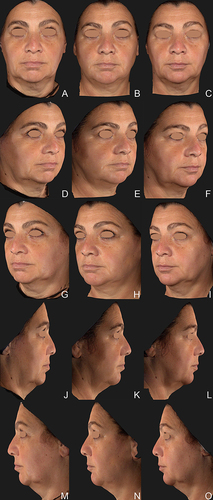Figures & data

Figure 1 Clinical algorithm for facial contour approach. CaHA(+) (Radiesse ®(+); Merz North America, Inc., Raleigh, NC, USA) should be the base for the lower face treatment for all patients, aiming for aging prevention (prejuvenation) in younger patients and to address laxity, sagging and loss of contour in older patients. If needed, combination treatment with hyaluronic acid can be performed (HAV; Belotero® Volume and HAI; Belotero® Intense; Cohesive poly-densified matrix hyaluronic acid; Merz Pharmaceuticals GmbH, Frankfurt, Germany).
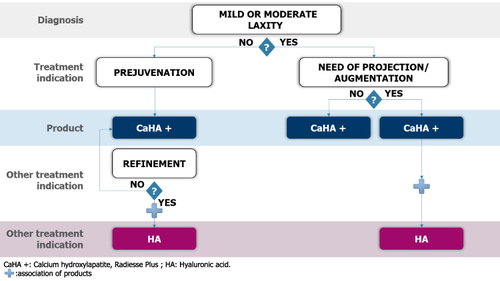
Figure 2 Possible treatment areas in the contouring plus technique (Frontal view): (Radiesse® (+); Merz North America, Inc., Raleigh, NC, USA). In purple, areas to be approached with a moldable hyaluronic acid, with balanced Gʹ hyaluronic acid (HAV; Belotero® Volume; Cohesive poly-densified matrix hyaluronic acid; Merz Pharmaceuticals GmbH, Frankfurt, Germany), whilst in red, areas in which a HA with high resistance to deformity (high Gʹ, Eʹ and Fn; HAI; Belotero® Intense; Cohesive poly-densified matrix hyaluronic acid; Merz Pharmaceuticals GmbH, Frankfurt, Germany) should be the choice. Round areas correspond to supraperiosteal plane of injection. The triangle and rectangle areas correspond to injections performed in the subcutaneous plane.
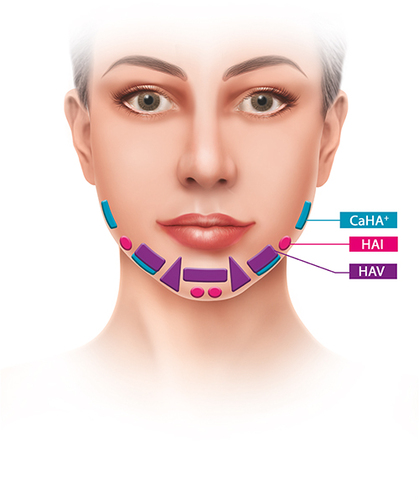
Figure 3 Possible treatment areas in the contouring plus technique (oblique view): (Radiesse® (+); Merz North America, Inc., Raleigh, NC, USA) should be performed slightly below the mandible body (blue rectangle), whereas if further definition of the mandible line is sought, a moldable HA (purple rectangle; HAV; balanced Gʹ; Belotero® Volume; Cohesive poly-densified matrix hyaluronic acid; Merz Pharmaceuticals GmbH, Frankfurt, Germany) can be injected along the mandible body in the superficial subcutaneous plane, superior to CaHA. In red, areas to be approached with a high Gʹ, Eʹ and Fn hyaluronic acid (red; HAI; Belotero® Intense; Cohesive poly-densified matrix hyaluronic acid; Merz Pharmaceuticals GmbH, Frankfurt, Germany). Round areas correspond to supraperiosteal plane of injection, whilst triangle and rectangle areas correspond to injections performed in the subcutaneous planeI.
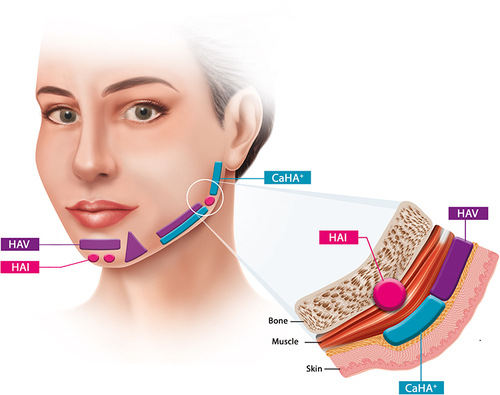
Figure 4 Clinical case 1: 34-year-old woman. In the chin: HAV 1mL was injected with cannula in the subcutaneous layer, while a 0.6 supraperiosteal bolus of HAI was injected with a 27-G needle, close to the inferior border of the chin. A total volume of 1.5mL of CaHA(+) per side was injected in the subcutaneous layer, slightly below the mandible ramus, along its length, while 0.5mL of HAV was injected in the superficial subcutaneous layer along the mandible ramus for further definition. Images taken with Vectra Software at baseline (A, D, G, J, M), after 30 days (B, E, H, K, N) and 90 days (C, F, I, L, O) after the treatment session.
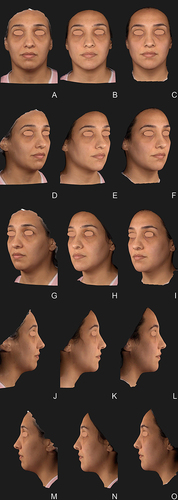
Figure 5 Clinical case 4: 44-year-old man. In the chin: 1mL of HAV was injected with cannula in subcutaneous layer in the crease, while supraperiosteal boluses of HAI were injected (0.3 lateral bolus/0.6 central bolus/0.3 lateral bolus) close to the inferior border of the chin. A total volume of 1.0mL of CaHA(+) per side was injected in the subcutaneous layer, slightly below the mandible ramus, along its length, while 0.5mL of HAI was injected in the supraperiosteal plane in the mandible angle. Images taken with Vectra Software. at baseline (A, D, G, J, M), after 30 days (B, E, H, K, N) and 90 days (C, F, I, L, O) after the treatment session.
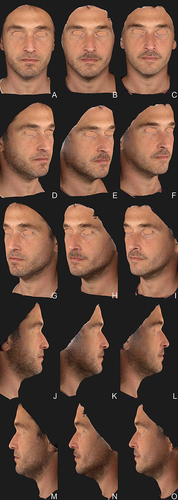
Figure 6 Clinical case 3: 29-year-old man. In the chin: 1mL of HAV was injected with cannula in subcutaneous layer in the crease, while supraperiosteal boluses of HAI were injected (0.3 lateral bolus/0.6 central bolus/0.3 lateral bolus) close to the inferior border of the chin. A total volume of 1.5mL of CaHA(+) per side was injected in the subcutaneous layer, slightly below the mandible ramus, along its length, while 0.5mL of HAI was injected in the supraperiosteal plane in the mandible angle. Images taken with Vectra Software. at baseline (A, D, G, J, M), after 30 days (B, E, H, K, N) and 90 days (C, F, I, L, O) after the treatment session.
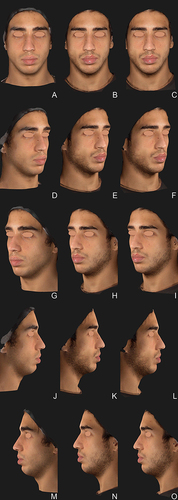
Figure 7 Clinical case 2: 54-year-old woman. A 0.6mL supraperiosteal bolus of HAI was injected in in the pogonium (most anterior point of the chin) and 0.7mL of HAI was injected in each side of the pre-jowl sulcus. A total volume of 1.0mL of CaHA(+) per side was injected in the subcutaneous layer, slightly below the mandible ramus, along its length, while 0.5mL of HAV was injected in the superficial subcutaneous layer along the mandible ramus for further definition. Images taken with Vectra Software. at baseline (A, D, G, J, M), after 30 days (B, E, H, K, N) and 90 days (C, F, I, L, O) after the treatment session.
